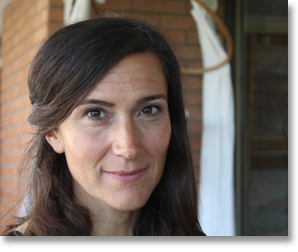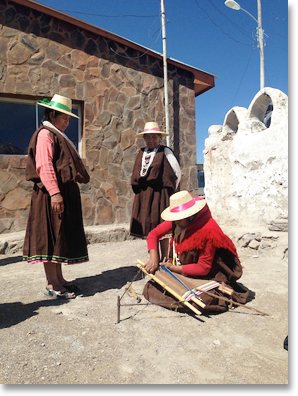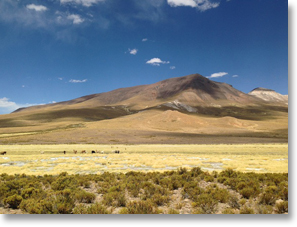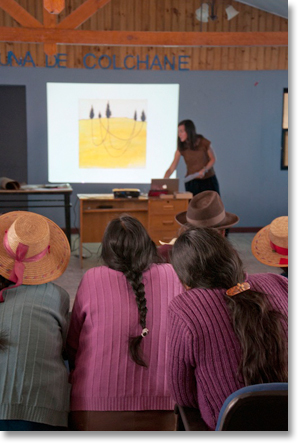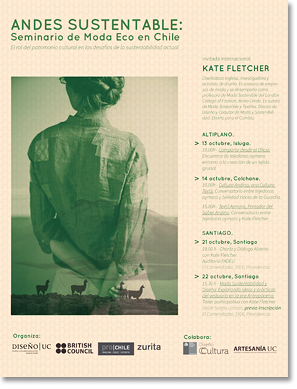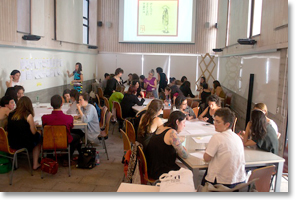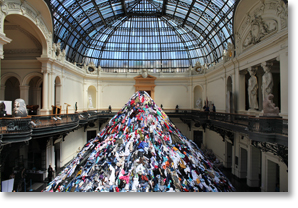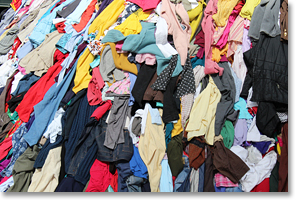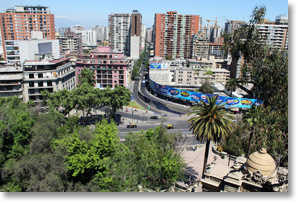|
An Interview with Kate Fletcher
The Lives of the Users of Clothes “What the future looks like” Santiago, Chile
Interview Quick Links:
In Motion Magazine: Would you like to talk a little about your Liverpool background and how you ended up being involved in fashion and sustainability? Kate Fletcher: I grew up in a very poor part of urban Northern England, a place that was very affected by Margaret Thatcher’s policies. I think that everybody in Liverpool still has a very strong anti-establishment tendency. There's loads of jokes in Liverpool about turning things upside down ... (Here's) one of my favorites, which you might appreciate being from the UK. There’s a radio phone-in and people are discussing what the second city of the UK is. People were saying, “Oh, I think it must be Manchester or Birmingham.” And then a scouser, a person from Liverpool, that’s what we call them, phoned in and said, “Look, it’s no contest. The second city of England is London.” (laughter) And so it goes on. There’s a very strong left-wing political energy in Liverpool. I grew up in a family of people who lived very close, cheek by jowl with other people, did a lot of sharing. There was a lot of strong community value in both of my parents. They organized crazily on a local level. But I realized when I left Liverpool about trees; because there wasn’t anything green in sight of the house that I grew up in with my brothers and sisters. Only as I’ve grown older have I realized that the natural world is the true medium that I’m meant to move in; green space, rather than the urban space. As a child I had no sense of what that was. From there, I just carried with me a very strong political agenda which was expressed as a feminist, as a young woman. Then, I just emerged in lots of other ways. I was really interested in making things. I made clothes. All of my grandparents worked in factories and they made clothes and I made clothes and that was what we did. We were a poor family and fabric was cheaper than fully-made garments -- and so we made. Those two strands – nature and politics - then folded together over time. I am who I am now because of that and many other things. In Motion Magazine: In many ways, except where profit ends up, the fashion industry focuses on women. Women are the majority of who does the actual production and who gets marketed to. Even the people who are solving the problem are mostly women. Could you talk about that? Kate Fletcher: I think it’s a 60-40 split actually. Forty percent of fashion is menswear and 60 percent is womenswear. And you are right in all of the other points. Almost entirely, the production of clothes is done by women. It requires nimble fingers. It’s a cheap technology; a sewing machine is extremely cheap. It’s not really changed much over many years. It’s very basic. It’s just a needle with some thread and a pair of scissors. And it’s been seen as one of the domestic arts, I suppose, which puts it firmly within the camp of women’s work. In a way, I think what has been quite good is there’s a new wave of feminism where some of these domestic arts are being reclaimed and politicized. I think that is really good. But going back to your other point. Yes, it’s a sector that is dominated by women; in terms of production (though,) many of the senior significant roles are held by men. Almost entirely in these factories, when you go and have a look around, the management is male and all the workers are female. When you tangle these threads of gender throughout you begin to see these garments are made in factories by women; often offering important sources of employment for women. People perhaps would have very few opportunities otherwise, maybe prostitution, other things. So, it’s positive in that way. Next, these garments enter homes where, largely, they are cared for by women. Also, they are in a system, the fashion industry, where the ideas and imagery are largely targeted at women. Women’s lack of self-confidence, vulnerability, lack of self-esteem is all manipulated within this whole business. It’s a flawed business but it’s also a place where women are beginning to lead the transformation of this business. I almost entirely deal with women when I work on sustainability issues. Every audience I deal with is at least 90 percent women. In almost all the courses I teach there are one or two men, very few men. It’s funny, I’ve often considered why that is and I was talking to somebody and she suggested that women in our practice in the past, and now today, are better able to make metaphorical leaps to imagine different futures and not just an incremental version of what we have today, which apparently men tend to work towards. I don’t know if that’s the case. I happen to think that perhaps it’s more associated with an ethic of care. Women have been closer to caring for things, for objects, for people, perhaps, than men have -- particularly in occidental culture. I don’t really know why, but that’s just the reality sometimes. In Motion Magazine: I read the work, the book you did with Lynda Grose, Fashion & Sustainability: Design for Change and I watched the video of your presentation in New York at Parsons The New School for Design. It seems that the essence of what you are saying about sustainability is on the one hand we have to understand what the limits of our resources are, while on the other hand undertaking a system of values based on care and shared responsibility. You say that responsibility is basically horizontal, with no hierarchy, offering equal opportunity for people to be involved, to take responsibility. Additionally, you talk about some of the main areas for possibly trying to fix the problem. You mention localism, co-design, slow design. So, a) did I get that right? And, b) can you talk about that? Kate Fletcher: That was a good summary. It seems that the challenge we face is to embrace a vision for fashion, for garments, for the dressed body -- to create a vision for that in a resource scarce world. But also to create a vision for that that in the core of our beings as humans does us well. The iteration of fashion that we see at the moment does none of that. I strongly suspect that that’s largely because of the commercial, the capitalist priorities that fashion is wedded to. You are right in that I spend a lot of time trying to give shape to alternatives and my hope is that I can somehow articulate or formulate or visualize a series of alternatives based in localism, in perhaps a change in the speed or the rhythm or pace with which people engage with things. And lots of other things besides. I try to do that in order to show people a plurality, a multiple view of what we can do rather than the sort of monological perspective that we see at the moment. Recently, in a conversation I had with a colleague of mine at Cambridge University in the UK, he said, “I think I can sum up, Kate, what your life’s work is about in four words.” He said to me, “Is it about buying less and washing less?” -- as in laundering less. I felt extremely uncomfortable for quite a long time because actually that is the effect of many of the things that I do. It is seeking to shrink the resource impact of the activities. But I realize that is only a small part of what it is, because it is not an expression of the positive vision of how we might live. He’s an engineer so he has a very sort of engineering perspective of it. But in a way it’s like the end of a thread that you begin to pull on and then you see whole lives are changed because of those priorities. In Motion Magazine: One of the things that you mentioned in your talk at Parsons was the point of sale; that you have to bring in time and the use value after the point of sale -- not just exchange value. Kate Fletcher: Yes. In Motion Magazine: That after the point of sale someone is going to live with that garment, and it becomes a process. This is really starting to talk about a post-growth way of looking at life, which seems to be very valuable. Kate Fletcher: Yes, yes, yes. Of course. The fashion industry puts a tremendous amount of effort into what happens up to the point of purchase. Everything from the spectacle of the catwalk, the glamour, the elegance, maybe just the theater, the pure drama, which is just so exhilarating. Have you ever seen a catwalk show, a runway show? In Motion Magazine: No. Kate Fletcher: It’s like a piece of theater. That’s what it is designed to be. It’s impactful. It’s sort of tingly. It makes you, “Oh, my goodness, this is just such a spectacle.” A massive amount of effort goes into that. A massive amount of effort goes into presenting the garment as perfect, pre-worn. In a boutique-type situation, you can imagine, even if you just peer through the window, you can see them on these rails. I suppose it’s like a perfect version of your future self. You can almost imagine you inhabiting this future world. And these garments are presented on bodies that no one owns, no one inhabits, except these very few -- this small group of model women. No one inhabits a body like that. The garments never look the same as you try them on. All this effort is put into that moment of creating an image, which is enough to seduce you to buy again because you are trying to create a future image of yourself, better than today. And all of this effort is put into it and almost no knowledge is held by the fashion industry of what happens to that garment the moment it leaves the store. They are required by law to do tests on fabric. Everything from a rub test so that the garment doesn’t shed the dye all over your white sofa, to fireproofing tests. They test the fabric for physical qualities. But nobody ever has a sense of what this garment is in the real world, in lives. How it looks six months on. Three years on. Nobody knows. And I was really interested in what would happen if garments could only be shown in magazines after they’d been worn for a while so you would see how slouchy it had become, how stretched, how well it had been made. There’s a real disconnect between the lives that people lead and the way that the fashion industry operates. (I’m) trying to open that up and to reach into the lives of the users of clothes -- to connect what happens in design with what happens in use. To see them as part of the same whole is a very radical change. It requires an entirely different type of thinking. It’s not based in controllable, fixed, knowable bits of information. You can’t imagine how it is. At the moment, everything is attempted to be controlled by the sector. They blend fiber so that there’s no variation between. Everything is standardized. There has to be a massive shift in people’s skills and preparedness -- to engage and talk with humans again. I think intellectually people can grasp it. I don’t think practically anyone else knows what on earth it is to work that way. I have had a go. I have worked that way for about five years. I’ve worked with some students and other people and even young people with wonderfully flexible brains, without the prejudices of the past, even they don’t know how to begin with different sorts of information that isn’t just about an idea. Trying to create fashion is an idea. (I’m) trying to create fashion as something which is much more grounded in people’s lives. (Even) they don’t know how to do that. We have a lot of work to do to make that happen. One of the things that often people claim drives fashion consumption is the deceit of novelty. It makes you discard the previous item and look for a new one because you are trying to create a new version of yourself, constantly. And that seems to work up to a certain point. But then you would say to somebody in their favorite cardigan, for example, “Well, you have had that for twenty years, would you like to get rid of it because it is no longer novel?” And they go, “No way! No way am I going to get rid of my favorite cardigan.” You realize that actually novelty isn’t the driver. There’s a sense that the things that people are accessing, buying, the garments that they are putting on their body just aren’t actually meeting their needs. To draw a little analogy to what I read about the way that cows graze -- as a way to explain it -- when cows are locked in a barn and are fed feed what they do is they continue to eat. They have no ability to self-regulate the amount. They just continue to consume the feed that is piled into the trough. (But when) you turn these cows out into the field, with their very sensitive mouth; they go around detecting the different herbs or bits of grass or whatever it is that they want to eat. Very carefully they soon decide which bits they want to eat and graze those bits. Very quickly they self regulate -- in terms of volume -- the amount that they eat. The theory goes that the cows in the barn are eating because they are searching for the nutrients that aren’t in the feed mix that they are being given. They are always searching for the thing that they need in order to balance their own nutrition. When you turn them out into the field, then they have a choice of what they choose to eat in order to balance their nutrition. When they have balanced it, then they stop because they feel they have had sufficient. You can draw an analogy very quickly with what is happening in the fashion context. People keep on consuming because what they are buying isn’t meeting their fashion nutrition requirements. Actually, when I realized that perhaps this was the case, it became very revealing that the problem is that the things that are being provided for people to buy in the system that we are all locked into isn’t giving people what they need. It is probably self-evident to loads of people, but perhaps that offers us an opportunity to think again and in a fresh way about what the challenges that we face are. It is not just a challenge of reducing the volumes that people consume; it’s changing how we consume. It’s changing the things that we consume. It is changing across all these different matters. It’s a root and branch reformation of things. In Motion Magazine: Did you learn things about sustainability on your trip to the Atacama? Kate Fletcher: Oh, my goodness. It was amazing. It was such a privilege, to see people whose lives have not been disconnected from the natural world. We had a driver, just a regular bloke from the town who we paid to take us round. He wasn’t a tour guide at all, he was just a bloke who lived in the village, and he knew every plant and bird type and mountain name, everything. The ecological literacy of the Aymara people I just found phenomenal. I was really moved by their sensibility and by their connection to the Earth. I found that really amazing. As a group of people their living conditions were basic. And it’s true to say that they had a great appetite for material culture. They really wanted things. I took some sweets and they wanted them and they wanted the jar. They like things and yet that happened at the same time as a wonderful gentleness and compassion for each other. They were really easy to laugh and to share convivial experiences. I think there’s competition between them in terms of sharing weaving techniques -- I think it’s changed probably to how it was even thirty years ago. I think it has shifted. But still, from my eye, which is a Western eye, I saw such humanity. I found it intoxicating. When I first got there, I had terrible altitude sickness. I was laid low -- it was awful -- on the first day after we arrived. I was really ill. I developed an oxygen habit. I slept in a room where they were preparing food, llama and quinoa and potatoes and other things. The place where the ceremony that we were involved with and the workshops we were involved with were in a village where nobody lives any more. It’s just used for parties and ceremonies. The houses are largely abandoned or just used very occasionally when people come back to the village, or a big fest, or whatever. And somebody found me a bit of a corner to lie in, in my stupor. I lay there and this Aymara family took care of me. I lay on my side watching them preparing this feast for a hundred people and chatting gently amongst each other. Taking care of a disabled child. Taking care of disabled me. I missed all of the exciting stuff, the weaving demonstrations because I was just so poorly. But I felt it was just such a privilege to watch them interact. To have some of their care extended to me. It was beautiful. In amidst of the vomiting (laughs). I learned what the future looks like, I suppose. These weavers are also farmers In Motion Magazine: Raúl Zibechi in his book Territories in Resistance writes about Indigenous cosmologies not so much going back to the past but trying to restore the balance, and that seems similar to what you are saying. In your book Fashion & Sustainability: Design for Change you talk about, “Restoring the relationship between fashion and the social and ecological system that supports it.” Does that connect to what you were just saying? Kate Fletcher: It was really interesting to see the weavers creating, I’ll call it fashion, just in the sense of use of textiles because it was very much an expression of the ecological and social systems that support it in that context. For these weavers are also farmers. They are the people with the herd of llama and they do the wonderful rituals where they show their love, the importance of the llama, and decorate with all the various Pachamama related things. The significance of pattern to who they are as Aymara also was significant. It’s absolutely an expression of those things. But that then sits alongside with how they see what they produce for tourists, which is entirely different. They don’t make any of the things that they use to carry a baby in, or the decorative belts of the various cloths that they use for the Pachamama ceremonies. They don’t have those to sell for tourists. You see a very clear distinction between things that are for their own use and the things that are for other people’s use. It’s quite a distorted view that people from outside get, I imagine, when they are looking at what these folks do and what they create. I think that many of the practices that they engage in are an expression of ecological and social support systems, but the message gets garbled and mixed up as it gets sent out into the world -- into their idea of what the world is and what the world wants. It’s possibly because they don’t have confidence that their things are the way forward. It’s complicated because the things that tourists buy or things that they offer tourists are then in a reinforcing circle. What tourists buy, they make more of them -- and then they sell them to tourists. The things that they are making aren’t an expression of the social system but often they are an expression of the ecological system because they are made with llama or alpaca, because that’s all they have. I think knitting it all together is essential. It is not done in that way at the moment and yet when you see what they produce for their own lives, the way that they dry the quinoa on the floor of their house on a wonderful piece of woven, finely, finely woven alpaca cloth, you see the role that textiles play. You see an expression of what I think I’m interested in, what this future is. But it gets a funny translation into the world beyond their small communities. It’s not bringing it to scale. I’m not interested in bringing it to scale, per se. Lots of people are. But even in trying to figure out how it is ported from their context to others, I think it needs a lot of consideration. In Motion Magazine: You were talking about small community and you mention in your book that some people say we need to go to localism and you say, “Yes, but that that’s not necessarily true”. Can you talk specifically about the advantages of how localism can work and also go through the ideas of co-design and slow design? Kate Fletcher: There’s a general feeling, and I suppose I share it also, that localism is a good thing. I think I feel it in my spirit. I feel very drawn to it as an idea. But I don’t know, certainly out of the Andean context, in a UK context, for example, I don’t know what local means in a fashion context. Recently, I’ve realized that it’s probably not the heritage tweed or Barbour jacket that is often put forward as an image of local garments in a UK context. It’s not Harris Tweed or tartan or all of these things. It’s probably very cheap polyester or nylon because that’s the abundant material in most of the UK. Perhaps I’m digressing a little, but localism from where I sit has to start with a real sense of what the resources and the assets and the skills that we have locally are. There’s a fabulous Wendell Berry line, which goes, “We came with visions, but not with sight. We did not see or understand where we were or what was there ...” One of the big realizations that I have had even in the last year is that we probably don’t really know what we have any more in the West. What constitutes localism? We’ve lost track of that. So, I’m very interested in figuring out what that is and perhaps starting from brass tacks, back down, and beginning to look without prejudice, including the bits that aren’t the attractive bits, to actually see what we have and then building up from a sense of that. Certainly, from the way that I see it, local is essential for helping people take responsibility for things. I think that for something which is close to home you can understand it more. When it’s more comprehensible it’s easy to take responsibility for it. I see that active taking of responsibility is important in effecting change. Co-design and people’s skill level In Motion Magazine: Can you talk about co-design? Kate Fletcher: Co-design is very interesting in a garment context as it often misses depending on people’s skill level. Making garments yourself often leads to people feeling disappointed with them. This is just based in the reality of how it is for people. Often they are very much more alert to the flaws, to the errors, to the slightly dodgy bit of sewing under the seam. The garments don’t have the sheen of perfection that a manufactured garment with the skilled seamstress seems to have. Interestingly, there’s a reluctance around these people who make garments to see them as good enough. When homemade garments are not worn it’s often for reasons that anybody else other than the person who made it would be oblivious to. People are incredibly critical. Because they don’t know the flaws in the mass-manufactured garment, they are seeing this thing as somehow inferior. Co-design potentially offers a way to circumvent that by designing with somebody who perhaps has some professional skills, and developing things in conjunction with others. Maybe then having other people make them. I think it could be good. But within a fashion context where things are shifting, where imagery, silhouette, color, texture are shifting all the time as part of this restless search of who we are, it raises some very interesting challenges. The challenge I think is how you can reconcile the needs for the long term and the desires for the short term. I don’t know if co-design is the best route to do that in a garment context. I think it’s complicated in a way that maybe co-design in a building isn’t. It’s complicated by the fact that garments are not just material products, they are a social system. That makes it tricky. In Motion Magazine: How about slow design? Kate Fletcher: At the moment, there’s one register of speed in the fashion industry and that’s fast. We are now in a situation where there is almost continuous replenishment of garments in stores, rather than a bi-yearly season. In Motion Magazine: And now there’s new stores where it’s super fast? Kate Fletcher: Three weeks from the design leaving the designer’s sketchbook/studio/workspace to it being made and then in-store to buy. That means that they can pick up very quickly on a new color or something that is happening and put it in the store. Where as we used to have an autumn/winter and a spring/summer season, now it’s pretty much continuous replenishment. There’s at least three or four mini seasons within each spring/summer. In a shop like Zara, it’s continuous. They just drop new stuff in the whole time. Bring people in-store again, and then again, again, and again. Not just once in spring to see what there is but again and again. It opens up more and more opportunities to consume. I think slow culture offers a nice way to think about this register of speed differently and to expose it as largely being a product of economic logic and business models at the fast speed just trying to generate more sales, more profit. Slow offers an opportunity to perhaps think about what we really need a bit more. What we like. And what that will be. Who benefits from the production. Slow isn’t necessarily durability only. Although many people think it’s things that are slow to consume. It’s not just the design classics; it’s lots of other things too. As I’ve thought about it more and more, we begin to see that it’s not rooted in the garments themselves at all. It’s rooted in the people who use them. It’s whether they have an openness to engage with these garments in a different way. I think that this shift from considering ideas of slow, or even co-design, or localism as material phenomena, is first and foremost transforming into understanding it as a social phenomenon. This shift from viewing the challenges we face largely as material phenomena as much more social phenomena is giving us more sophisticated, more nuanced responses. Up to this point, we have been trying to manipulate materials in various configurations to make them more efficient, less polluting, better for workers. But what we see actually is we are just creating products that are slotting into a system of society’s use of garments. That is to say until we manipulate that, big change will be slow to happen. I think all of these things are exciting. Slow culture in particular is a very sticky idea, very interesting to people. It sticks in their brain. They like it. It seems to have power and resonance -- perhaps because pairing it with fashion seems almost difficult to hold in your head at the same time. I think it’s more than that. I think it’s because it’s trying to recognize that we can combine pleasure with political engagement in clothing. You can embrace fashion as part of culture at the same time as really understanding it as a political entity, engaging with the politics of the whole production chain -- all the people, all of these things. You can hold onto the fact that it’s important to a sense of identity, to communication, to an aesthetic sense. To all of this. It’s extremely important. A direct expression of who we are In Motion Magazine: One of the things that always took me back as I learned more about textiles and clothing was the word “fashion”. I can understand the context of clothing but how did we get from the “rag trade” (which I believe is an English expression) to “haute couture” fashion. Is that all just marketing? What does fashion really mean? Kate Fletcher: What does fashion really mean? Fashion is an expression of time and place. It’s not exclusive to garments, though the short hand, the way I use it, I talk about it in the garment context. There’s a fashion in a mobile phone, or in cars, in typography. It’s a moment. It’s a connection to this time, this place -- an expression of that, a visual, often a material expression of that. It’s everything from identity formation, communication, to a multi-million pound global industry based on production and consumption of garments. I don’t think that any garments exist outside of fashion cycles and trends. I think that they all do, just in a more obvious way on the edges of this sort of spinning wheel than others. There are shifts and changes in all of this. To dress in the morning is to engage with fashion. The shift from the rag trade to haute couture. Well, from the point at which garments were used to dress the French court and to share exclusivity, to divide, to show people’s status and wealth, right down through the emergence of ready-made garments after the Second World War, the mass production of garments, people have been watching a changing sector. A sector that is highly mobile but produces quite cheap products, generally, and getting cheaper, that certainly for me, at any case, are a direct expression of who we are. So -- how we got from the rag trade to haute couture. It’s a feature of so many different cultural shifts. It’s about shifts. It’s about industrialization. It’s about division of labor. It’s about the rise of the neoliberal market economy. It’s about individualism. It’s about people shifting from doing things to watching, to looking rather than doing, that then promotes the surface of the compass of communication of who we are, rather than the detail, the craft of practice. You can roll forward to the present day and look at phenomena like Facebook. I’ve had huge numbers of people say to me that Facebook and the constant taking of pictures of yourself and then posting it on Facebook is a huge incentive for people to go out and buy more clothes. They are taking so many more pictures of themselves and sharing it with friends that they are very aware that they are wearing the same garments again and again and again and they don’t want to do that. So, they are constantly changing them. You see, it’s not how we got from the rag trade to haute couture; it’s more about how we got from the rag trade to a bigger rag trade. Then, within that there all of these different positions between who includes, exclusives, which then of course filters down in various ways, shapes, and forms through the mass market. Within post modernism there’s sort of an obligation to experience everything, and so now people are buying garments for every purpose. You almost don’t dare jump on your bike without the right clothes to dress in. You don’t dare go skiing without the full outfit. Or you don’t dare go to the opera without the right (garment). There’s this cultural obligation to experience everything with people acquiring things along the way. There are all of these trends within the U.S., and the UK too, of having a self-storage unit because you can’t quite fit all the things you own in your own home. You put them there because you don’t want to throw them away, but actually you never access them again. Before coming to Chile, I looked at some of the statistics of consumption patterns here for garments. On average, it’s between a three and five percent increase in consumption in sales in Chile, year on year. It has just recently overtaken China and the United Arab Emirates as the preferred developing country to invest in for fashion. Chile is the one that is growing most rapidly. What we see is an appetite for one of the first things that people do to communicate apparent wealth, and actual wealth, which is to convey that through the garments that they put on their backs. In a strange sort of way, that’s how we got from there to here. Published in In Motion Magazine January 10, 2015
For more information, visit:
|
||||||||||||||||||||||||||||||||||||||
If you have any thoughts on this or would like to contribute to an ongoing discussion in the  What is New? || Affirmative Action || Art Changes || Autonomy: Chiapas - California || Community Images || Education Rights || E-mail, Opinions and Discussion || En español || Essays from Ireland || Global Eyes || Healthcare || Human Rights/Civil Rights || Piri Thomas || Photo of the Week || QA: Interviews || Region || Rural America || Search || Donate || To be notified of new articles || Survey || In Motion Magazine's Store || In Motion Magazine Staff || In Unity Book of Photos || Links Around The World NPC Productions Copyright © 1995-2018 NPC Productions as a compilation. All Rights Reserved. |



